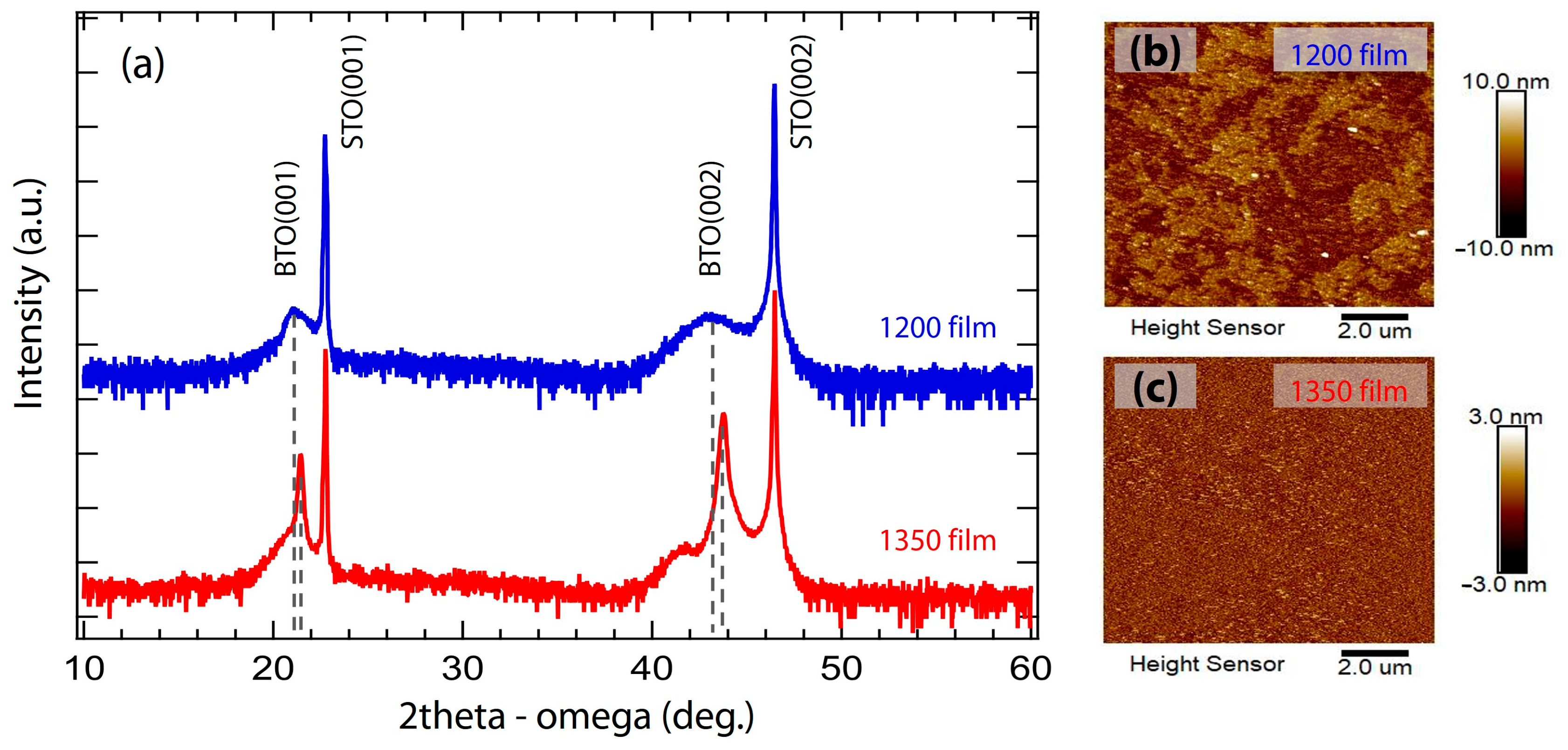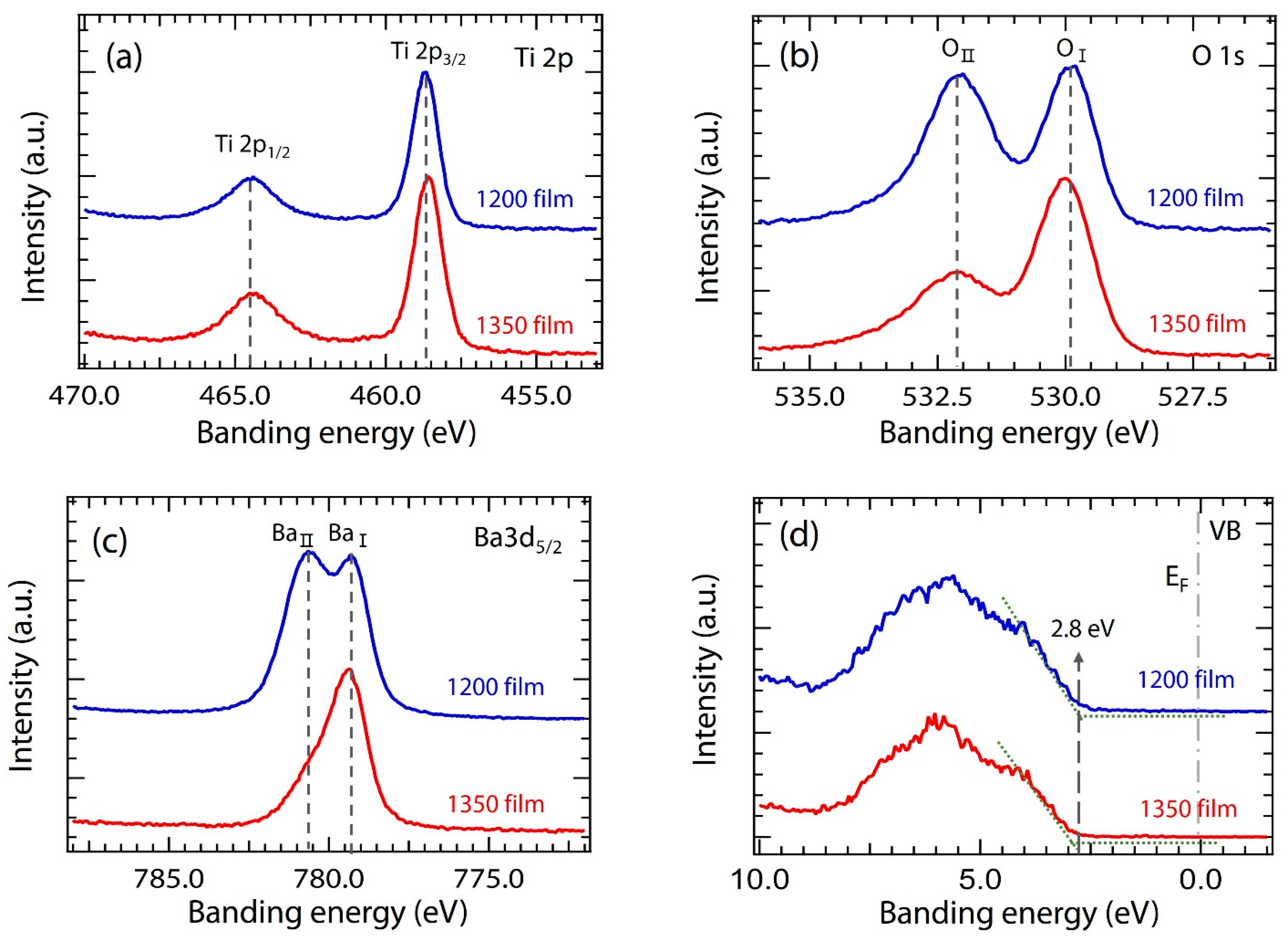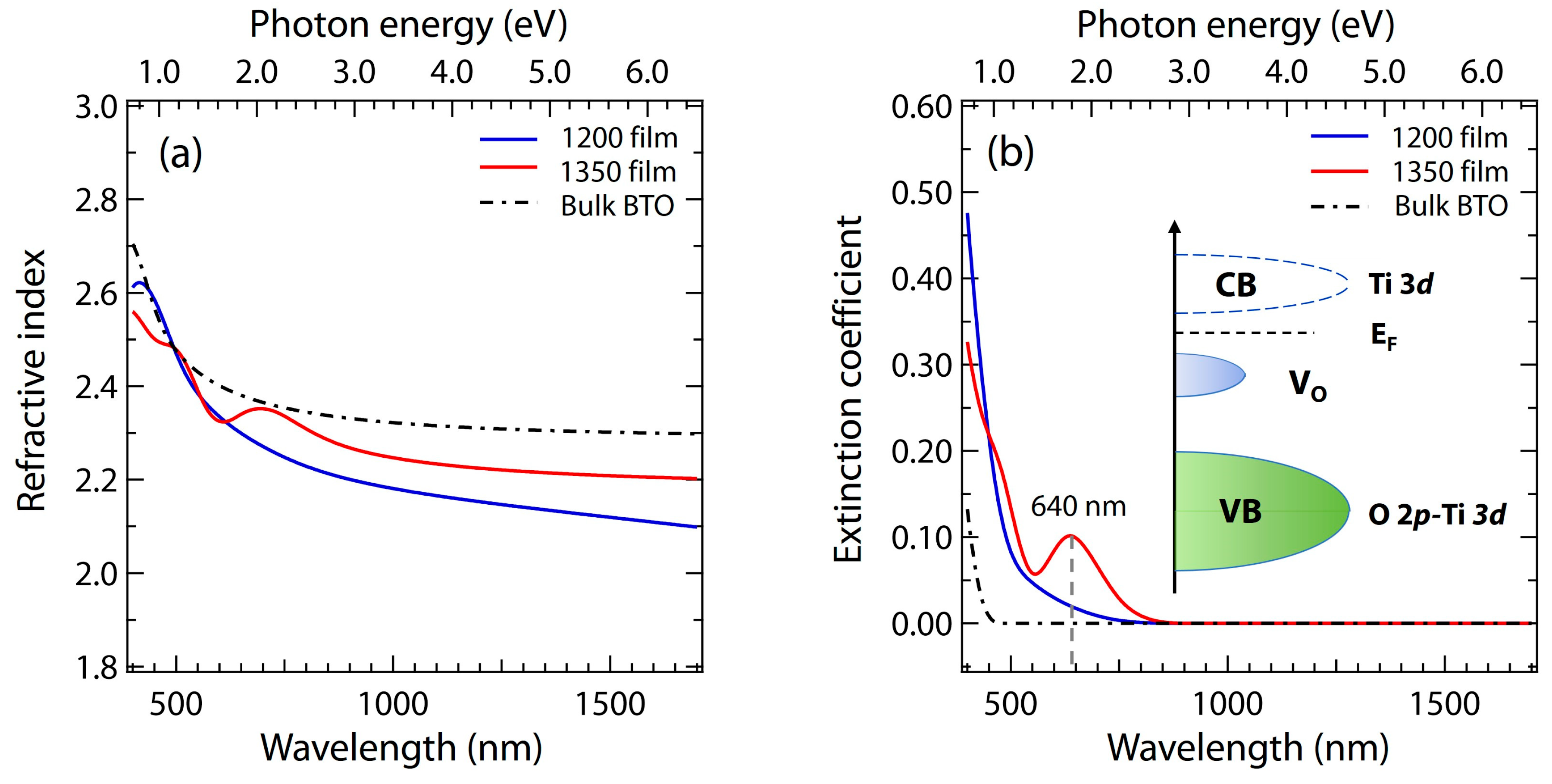The Effect of Sputtering Target Density on the Crystal and Electronic Structure of Epitaxial BaTiO3 Thin Films
Abstract
:1. Introduction
2. Experimental Procedure
3. Results and Discussion
4. Conclusions
Author Contributions
Funding
Data Availability Statement
Acknowledgments
Conflicts of Interest
References
- Dawber, M.; Rabe, K.M.; Scott, J.F. Physics of thin-film ferroelectric oxides. Rev. Mod. Phys. 2005, 77, 1083–1130. [Google Scholar] [CrossRef]
- Martin, L.W.; Rappe, A.M. Thin-film ferroelectric materials and their applications. Nat. Rev. Mater. 2016, 2, 16087. [Google Scholar] [CrossRef]
- Schlom, D.G.; Chen, L.-Q.; Eom, C.-B.; Rabe, K.M.; Streiffer, S.K.; Triscone, J.-M. Strain Tuning of Ferroelectric Thin Films. Annu. Rev. Mater. Res. 2007, 37, 589–626. [Google Scholar] [CrossRef]
- Li, F.; Zhang, S.; Damjanovic, D.; Chen, L.-Q.; Shrout, T.R. Local Structural Heterogeneity and Electromechanical Responses of Ferroelectrics: Learning from Relaxor Ferroelectrics. Adv. Funct. Mater. 2018, 28, 1801504. [Google Scholar] [CrossRef]
- Wang, C.; Zhang, M.; Chen, X.; Bertrand, M.; Shams-Ansari, A.; Chandrasekhar, S.; Winzer, P.; Lončar, M. Integrated lithium niobate electro-optic modulators operating at CMOS-compatible voltages. Nature 2018, 562, 101–104. [Google Scholar] [CrossRef]
- Thomaschewski, M.; Bozhevolnyi, S.I. Pockels modulation in integrated nanophotonics. Appl. Phys. Rev. 2022, 9, 021311. [Google Scholar] [CrossRef]
- Veithen, M.; Gonze, X.; Ghosez, P. First-Principles Study of the Electro-Optic Effect in Ferroelectric Oxides. Phys. Rev. Lett. 2004, 93, 187401. [Google Scholar] [CrossRef]
- Vogler-Neuling, V.V.; Karvounis, A.; Morandi, A.; Weigand, H.; Dénervaud, E.; Grange, R. Photonic Assemblies of Randomly Oriented Nanocrystals for Engineered Nonlinear and Electro-Optic Effects. ACS Photonics 2022, 9, 2193–2203. [Google Scholar] [CrossRef]
- Zgonok, M.; Bernasconi, P.; Duelli, M.; Schlesser, R.; Günter, P.; Garrett, M.H.; Rytz, D.; Zhu, Y.; Wu, X. Dielectric, elastic, piezoelectric, electro-optic, and elasto-optic tensors of BaTiO3 crystals. Phys. Rev. B 1994, 50, 5941–5949. [Google Scholar] [CrossRef] [PubMed]
- Abel, S.; Stöferle, T.; Marchiori, C.; Rossel, C.; Rossell, M.D.; Erni, R.; Caimi, D.; Sousa, M.; Chelnokov, A.; Offrein, B.J.; et al. A strong electro-optically active lead-free ferroeletric integrated on silicon. Nat. Commun. 2013, 4, 1671. [Google Scholar] [CrossRef]
- Xiong, C.; Pernice, W.H.P.; Ngai, J.H.; Reiner, J.W.; Kumah, D.; Walker, F.J.; Ahn, C.H.; Tang, H.X. Active Silicon Integrated Nanophotonics: Ferroelectric BaTiO3 Devices. Nano Lett. 2014, 14, 1419–1425. [Google Scholar] [CrossRef]
- Guo, W.; Posadas, A.B.; Demkov, A.A. Epitaxial integration of BaTiO3 on Si for electro-optic applications. J. Vac. Sci. Technol. A 2021, 39, 030804. [Google Scholar] [CrossRef]
- Mazet, L.; Bachelet, R.; Louahadj, L.; Albertini, D.; Gautier, B.; Cours, R.; Schamm-Chardon, S.; Saint-Girons, G.; Dubourdieu, C. Structure study and ferroelectricity of epitaxial BaTiO3 fims on silicon grown by molecular beam epitaxy. J. Appl. Phys. 2014, 116, 214102. [Google Scholar] [CrossRef]
- Winiger, J.; Keller, K.; Moor, D.; Baumann, M.; Chelladurai, D.; Konli, M.; Blatter, T.; Dénervaud, E.; Fedoryshyn, Y.; Koch, U.; et al. PLD Epitaxial Thin-Film BaTiO3 on MgO Dielectric and Electro-Optic Properties. Adv. Mater. Interfaces 2023, 11, 2300665. [Google Scholar] [CrossRef]
- Karvounis, A.; Timpu, F.; Vogler-Neuling, V.V.; Savo, R.; Grange, R. Barium Titanate Nanostructures and Thin Films for Photonics. Adv. Opt. Mater. 2020, 8, 2001249. [Google Scholar] [CrossRef]
- Reynaud, M.; Dong, Z.; Park, H.; Li, W.; Posadas, A.B.; Warner, J.H.; Wasserman, D.; Demkov, A.A. Microstructural analysis and electro-optic properties of thick epitaxial BaTiO3 films integrated on silicon (001). Phys. Rev. Mater. 2022, 6, 095201. [Google Scholar] [CrossRef]
- Towner, D.J.; Ni, J.; Marks, T.J.; Wessels, B.W. Effects of two-stage deposition on the structure and properties of heteroepitaxial BaTiO3 thin films. J. Cryst. Growth 2003, 255, 107–113. [Google Scholar] [CrossRef]
- Barbier, A.; Mocuta, C.; Stanescu, D.; Jegou, P.; Jedrecy, N.; Magnan, H. Surface composition of BaTiO3/SrTiO3(001) films grown by atomic oxygen plasma assisted molecular beam epitaxy. J. Appl. Phys. 2012, 112, 114116. [Google Scholar] [CrossRef]
- Fazlioglu-Yalcin, B.; Suceava, A.C.; Kuznetsova, T.; Wang, K.; Gopalan, V.; Engel-Herbert, R. Stoichiometric Control and Optical Properties of BaTiO3 Thin Films Grown by Hybrid MBE. Adv. Mater. Interfaces 2023, 10, 2300018. [Google Scholar] [CrossRef]
- Reynaud, M.; Chen, P.-Y.; Li, W.; Paoletta, T.; Kwon, S.; Lee, D.H.; Beskin, I.; Posadas, A.B.; Kim, M.J.; Landis, C.M.; et al. Electro-optic response in epitaxially stabilized orthorhombic BaTiO3. Phys. Rev. Mater. 2021, 5, 035201. [Google Scholar] [CrossRef]
- Abel, S.; Sousa, M.; Rossel, C.; Caimi, D.; Rossell, M.D.; Erni, R.; Fompeyrine, J.; Marchiori, C. Controlling tetragonality and crystalline orientation in BaTiO3 nano-layers grown on Si. Nanotechnology 2013, 24, 285701. [Google Scholar] [CrossRef]
- Posadas, A.B.; Park, H.; Reynaud, M.; Cao, W.; Reynolds, J.D.; Guo, W.; Jeyaselvan, V.; Beskin, I.; Mashanovich, G.Z.; Warner, J.H.; et al. Thick BaTiO3 Epitaxial Films Integrated on Si by RF Sputtering for Electro-Optic Modulators in Si Photonics. ACS Appl. Mater. Interfaces 2021, 13, 51230–51244. [Google Scholar] [CrossRef]
- Abel, S.; Eltes, F.; Ortmann, J.E.; Messner, A.; Castera, P.; Wagner, T.; Urbonas, D.; Rosa, A.; Gutierrez, A.M.; Tulli, D.; et al. Large Pockels effect in micro- and nanostructured barium titanate integrated on silicon. Nat. Mater. 2019, 18, 42–47. [Google Scholar] [CrossRef]
- Qiu, J.H.; Ding, J.N.; Yuan, N.Y.; Wang, X.Q.; Zhou, Y. Film thickness dependence of electro-optic effect in epitaxial BaTiO3 thin films. Solid State Commun. 2011, 151, 1344–1348. [Google Scholar] [CrossRef]
- Song, Y.; Liu, X.; Wen, F.; Kareev, M.; Zhang, R.; Pei, Y.; Bi, J.; Shafer, P.; N’Diaye, A.T.; Arenholz, E.; et al. Unconventional crystal-field splitting in noncentrosymmetric BaTiO3 thin films. Phys. Rev. Mater. 2020, 4, 024413. [Google Scholar] [CrossRef]
- Chen, A.P.; Khatkhatay, F.; Zhang, W.; Jacob, C.; Jiao, L.; Wang, H. Strong oxygen pressure dependence of ferroelectricity in BaTiO3/SrRuO3/SrTiO3 epitaxial heterostructures. J. Appl. Phys. 2013, 114, 124101. [Google Scholar] [CrossRef]
- Suzuki, T.; Nishi, Y.; Fujimoto, M. Effect of Nonstoichiometry on Microstructure of Epitaxially Grown BaTiO3 Thin Films. Jpn. J. Appl. Phys. 2000, 39, 5970. [Google Scholar] [CrossRef]
- Cao, Y.; Tan, S.L.; Cheung, E.J.H.; Siew, S.Y.; Li, C.; Liu, Y.; Tang, C.S.; Lal, M.; Chen, G.; Dogheche, K.; et al. A Barium Titanate-on-Oxide Insulator Optoelectronics Platform. Adv. Mater. 2021, 33, 2101128. [Google Scholar] [CrossRef] [PubMed]
- Leroy, F.; Rousseau, A.; Payan, S.; Dogheche, E.; Jenkins, D.; Decoster, D.; Maglione, M. Guided-wave electro-optic characterization of BaTiO3 thin films using the prism coupling technique. Opt. Lett. 2013, 38, 1037–1039. [Google Scholar] [CrossRef] [PubMed]
- Xu, J.; Yang, Z.; Zhang, X.; Wang, H.; Xu, H. Grain size control in ITO targets and its effect on electrical and optical properties of deposited ITO films. J. Mater. Sci. Mater. Electron. 2014, 25, 710–716. [Google Scholar] [CrossRef]
- Liu, S.; Chen, J.; Sun, B.; Huai, Z.; Xiong, F.; He, J. Evolution of microstructure of IGZO ceramic target during magnetron sputtering. Ceram. Int. 2022, 48, 7500–7511. [Google Scholar] [CrossRef]
- Wu, J.; Wang, Z.; Chen, F.; Shen, Q.; Zhang, L. Chemical evolution of target surfaces during RF magnetron sputtering and its effect on the performance of TCO films. Appl. Surf. Sci. 2019, 493, 665–672. [Google Scholar] [CrossRef]
- Omata, T.; Kita, M.; Okada, H.; Otsuka-Yao-Matsuo, S.; Ono, N.; Ikawa, H. Characterization of indium–tin oxide sputtering targets showing various densities of nodule formation. Thin Solid Film. 2006, 503, 22–28. [Google Scholar] [CrossRef]
- Lotkov, E.S.; Baburin, A.S.; Ryzhikov, I.A.; Sorokina, O.S.; Ivanov, A.I.; Zverev, A.V.; Ryzhkov, V.V.; Bykov, I.V.; Baryshev, A.V.; Panfilov, Y.V.; et al. ITO film stack engineering for low-loss silicon optical modulators. Sci. Rep. 2022, 12, 6321. [Google Scholar] [CrossRef] [PubMed]
- Anders, A. Physics of arcing, and implications to sputter deposition. Thin Solid Film. 2006, 502, 22–28. [Google Scholar] [CrossRef]
- Caillard, A.; El’Mokh, M.; Lecas, T.; Thomann, A.L. Effect of the target temperature during magnetron sputtering of Nickel. Vacuum 2018, 147, 82–91. [Google Scholar] [CrossRef]
- Hou, D.; Bi, J.; Yang, J.; Geng, H.; Wang, Z.; Lin, Z.; Li, B.; Ma, Z.; Liu, C.; Meng, Z.; et al. Polar metals with coexisting ferroelectricity and high-density conduction electrons. Appl. Phys. Lett. 2024, 124, 062903. [Google Scholar] [CrossRef]
- Chernova, E.; Pacherova, O.; Chvostova, D.; Dejneka, A.; Kocourek, T.; Jelinek, M.; Tyunina, M. Strain-controlled optical absorption in epitaxial ferroelectric BaTiO3 films. Appl. Phys. Lett. 2015, 106, 192903. [Google Scholar] [CrossRef]
- Gates-Rector, S.; Blanton, T. The Powder Diffraction File: A quality materials characterization database. Powder Diffr. 2019, 34, 352–360. [Google Scholar] [CrossRef]
- Hérard, C.; Faivre, A.; Lemaître, J. Surface decontamination treatments of undoped BaTiO3—Part I: Powder and green body properties. J. Eur. Ceram. Soc. 1995, 15, 135–143. [Google Scholar] [CrossRef]
- Xiang, H.; Zhang, F.; Yi, Z.; Ma, M.; Gu, Y.; Liu, F.; Li, Y.; Liu, Z. Non-Stoichiometry Induced Switching Behavior of Ferroelectric Photovoltaic Effect in BaTiO3 Ceramics. Phys. Status Solidi (RRL)–Rapid Res. Lett. 2019, 13, 1900074. [Google Scholar] [CrossRef]
- El Marssi, M.; Le Marrec, F.; Lukyanchuk, I.A.; Karkut, M.G. Ferroelectric transition in an epitaxial barium titanate thin film: Raman spectroscopy and x-ray diffraction study. J. Appl. Phys. 2003, 94, 3307–3312. [Google Scholar] [CrossRef]
- Puli, V.S.; Li, P.; Adireddy, S.; Chrisey, D.B. Crystal structure, dielectric, ferroelectric and energy storage properties of La-doped BaTiO3 semiconducting ceramics. J. Adv. Dielectr. 2015, 05, 1550027. [Google Scholar] [CrossRef]
- Perry, C.H.; Hall, D.B. Temperature Dependence of the Raman Spectrum of BaTiO3. Phys. Rev. Lett. 1965, 15, 700–702. [Google Scholar] [CrossRef]
- Lo, C.-F.; McDonald, P.; Draper, D.; Gilman, P. Influence of tungsten sputtering target density on physical vapor deposition thin film properties. J. Electron. Mater. 2005, 34, 1468–1473. [Google Scholar] [CrossRef]
- Tyunina, M.; Peräntie, J.; Kocourek, T.; Saukko, S.; Jantunen, H.; Jelinek, M.; Dejneka, A. Oxygen vacancy dipoles in strained epitaxial BaTiO3 films. Phys. Rev. Res. 2020, 2, 023056. [Google Scholar] [CrossRef]
- Hiltunen, J.; Seneviratne, D.; Tuller, H.L.; Lappalainen, J.; Lantto, V. Crystallographic and dielectric properties of highly oriented BaTiO3 films: Influence of oxygen pressure utilized during pulsed laser deposition. J. Electroceram. 2009, 22, 395–404. [Google Scholar] [CrossRef]
- Wang, J.L.; Gaillard, F.; Pancotti, A.; Gautier, B.; Niu, G.; Vilquin, B.; Pillard, V.; Rodrigues, G.L.M.P.; Barrett, N. Chemistry and Atomic Distortion at the Surface of an Epitaxial BaTiO3 Thin Film after Dissociative Adsorption of Water. J. Phys. Chem. C 2012, 116, 21802–21809. [Google Scholar] [CrossRef]
- Deleuze, P.-M.; Magnan, H.; Barbier, A.; Li, Z.; Verdini, A.; Floreano, L.; Domenichini, B.; Dupont, C. Nature of the Ba 4d Splitting in BaTiO3 Unraveled by a Combined Experimental and Theoretical Study. J. Phys. Chem. C 2022, 126, 15899–15906. [Google Scholar] [CrossRef]
- Wang, J.L.; Leroy, J.; Niu, G.; Saint-Girons, G.; Gautier, B.; Vilquin, B.; Barrett, N. Chemistry and structure of BaTiO3 ultra-thin films grown by different O2 plasma power. Chem. Phys. Lett. 2014, 592, 206–210. [Google Scholar] [CrossRef]
- Miot, C.; Husson, E.; Proust, C.; Erre, R.; Coutures, J.P. Residual carbon evolution in BaTiO3 ceramics studied by XPS after ion etching. J. Eur. Ceram. Soc. 1998, 18, 339–343. [Google Scholar] [CrossRef]
- Spasojevic, I.; Sauthier, G.; Caicedo, J.M.; Verdaguer, A.; Domingo, N. Oxidation processes at the surface of BaTiO3 thin films under environmental conditions. Appl. Surf. Sci. 2021, 565, 150288. [Google Scholar] [CrossRef]
- Droubay, T.C.; Kong, L.; Chambers, S.A.; Hess, W.P. Work function reduction by BaO: Growth of crystalline barium oxide on Ag(001) and Ag(111) surfaces. Surf. Sci. 2015, 632, 201–206. [Google Scholar] [CrossRef]
- Dupin, J.-C.; Gonbeau, D.; Vinatier, P.; Levasseur, A. Systematic XPS studies of metal oxides, hydroxides and peroxides. Phys. Chem. Chem. Phys. 2000, 2, 1319–1324. [Google Scholar] [CrossRef]
- Balaz, S.; Zeng, Z.; Brillson, L.J. Heterojunction band offsets and dipole formation at BaTiO3/SrTiO3 interfaces. J. Appl. Phys. 2013, 114, 183701. [Google Scholar] [CrossRef]
- Muff, S.; Pilet, N.; Fanciulli, M.; Weber, A.P.; Wessler, C.; Ristić, Z.; Wang, Z.; Plumb, N.C.; Radović, M.; Dil, J.H. Influence of ferroelectric order on the surface electronic structure of BaTiO3 films studied by photoemission spectroscopy. Phys. Rev. B 2018, 98, 045132. [Google Scholar] [CrossRef]





Disclaimer/Publisher’s Note: The statements, opinions and data contained in all publications are solely those of the individual author(s) and contributor(s) and not of MDPI and/or the editor(s). MDPI and/or the editor(s) disclaim responsibility for any injury to people or property resulting from any ideas, methods, instructions or products referred to in the content. |
© 2024 by the authors. Licensee MDPI, Basel, Switzerland. This article is an open access article distributed under the terms and conditions of the Creative Commons Attribution (CC BY) license (https://creativecommons.org/licenses/by/4.0/).
Share and Cite
Qi, F.; Peng, S.; Bi, J.; Zhang, S.; Su, G.; Li, P.; Zhang, J.; Zhang, T.; Zhou, W.; Zhang, R.; et al. The Effect of Sputtering Target Density on the Crystal and Electronic Structure of Epitaxial BaTiO3 Thin Films. Crystals 2024, 14, 304. https://doi.org/10.3390/cryst14040304
Qi F, Peng S, Bi J, Zhang S, Su G, Li P, Zhang J, Zhang T, Zhou W, Zhang R, et al. The Effect of Sputtering Target Density on the Crystal and Electronic Structure of Epitaxial BaTiO3 Thin Films. Crystals. 2024; 14(4):304. https://doi.org/10.3390/cryst14040304
Chicago/Turabian StyleQi, Fugang, Shaoqin Peng, Jiachang Bi, Shunda Zhang, Guanhua Su, Peiyi Li, Jiahui Zhang, Tengteng Zhang, Weisong Zhou, Ruyi Zhang, and et al. 2024. "The Effect of Sputtering Target Density on the Crystal and Electronic Structure of Epitaxial BaTiO3 Thin Films" Crystals 14, no. 4: 304. https://doi.org/10.3390/cryst14040304




